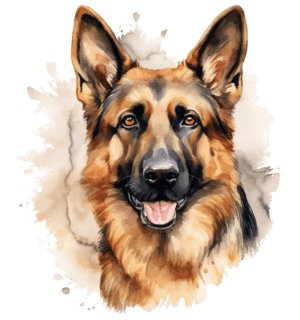We hope that the following common dog Q & A’s can answer some of the important questions that you have on your mind in relation to your pets.
—————————-
Make sure to check out today’s deals to SAVE money on dog products by clicking on the graphic below. Don’t miss out. This post contains affiliate links and I will be compensated if you make a purchase after clicking on my links.
————————
Table Of Contents
How Long Have Dogs Been Domesticated:
The earliest evidence of dogs being domesticated dates back to around 20,000 to 40,000 years ago. Archaeological findings suggest that ancient humans formed mutually beneficial relationships with wolves, the ancestors of modern dogs. These early dogs likely assisted humans in hunting, guarding, and possibly providing companionship.
According to some scientists, the South Asian wolf is believed to be the ancestor of all dogs.
————————-
What Are The Most Popular Dog Breeds:
The most popular dog breeds in the US are Golden Retrievers, Labrador Retrievers, German Shepherds, Beagles, and Bulldogs.
According to the source Spots.com, 53% of American households own dogs. Here is more information below on popular breeds of dogs.
————————-

Labrador Retrievers: Labradors are known for their friendly and outgoing nature. They’re highly intelligent and versatile, excelling in various roles like assistance dogs, search and rescue, and therapy dogs. They’re also excellent family pets due to their gentle demeanor and love for people.
——————————

French Bulldogs: Often referred to as “Frenchies,” are small, muscular dogs with charming and affectionate personalities. They have unique bat-like ears and a distinctive short snout. Despite their compact size, they have a sturdy build and are known for being good companions.
———————–

German Shepherds: They are highly intelligent and trainable dogs. They’re often utilized in police, military, and service roles due to their loyalty, courage, and versatility. They’re also loving and protective family dogs when properly trained and socialized.
————————-

Golden Retrievers: They are known for their friendly and reliable temperament. They’re great with children and are often chosen as therapy dogs due to their gentle nature. They have a dense, water-repellent coat and are known for their love of water and retrieving.
————————

Cavalier King Charles Spaniels: They are small dogs with a graceful yet sturdy build. They have distinctive, expressive faces with large, dark eyes that exude warmth and emotion.
The breed’s coat is silky and can come in various color combinations, including Blenheim (chestnut and white), tricolor (black, white, and tan), ruby (solid red), and black and tan.
———————-

Beagles: These dogs are known for their exceptional sense of smell and friendly nature. They’re often used as detection dogs at airports and other places. Beagles have a strong hunting instinct, so they might follow their noses if not properly trained or contained.
————————

Yorkshire Terriers: Also known as “Yorkies,” they are small dogs with big personalities. They’re known for their long, silky coats and are often seen as fashionable companions. Despite their small size, they can be feisty and energetic.
———————————

Dachshunds: Also known as “wiener dogs” or “doxies,” have elongated bodies and short legs. They were originally bred for hunting purposes, particularly for going after burrowing animals. They come in different coat varieties (smooth, longhaired, and wirehaired) and have distinctive personalities.
————————-
How Much Exercise Do Dogs Need:

The amount of exercise a dog needs or requires depends to a large extent on its breed, size, age, and health. However, most dogs need at least 30 minutes of exercise per day. This benefits both the dog and the owner.
The amount of exercise a dog needs can vary widely based on factors such as breed, age, size, individual health, and temperament. Generally, dogs require regular physical activity to maintain their physical and mental well-being.
High-Energy Breeds: Breeds like Border Collies, Labrador Retrievers, and Huskies are known for their high energy levels. These dogs often need more intense and frequent exercise, including activities like running, playing fetch, and engaging in agility training. They might need around 1 to 2 hours of exercise per day.
Medium-Energy Breeds: Breeds like Golden Retrievers, Boxers, and Beagles fall into this category. They still need regular exercise but might be content with a mix of brisk walks, playtime, and mental stimulation. Aim for around 30 minutes to 1 hour of exercise per day.
Low-Energy Breeds: Breeds like Bulldogs, Pugs, and Basset Hounds tend to have lower energy levels. They enjoy shorter walks and play sessions but can tire out more quickly. About 20 to 30 minutes of exercise per day might be sufficient.
Puppies: Puppies have bursts of energy but also require plenty of rest. Be cautious not to overexert them, as their developing bodies are more susceptible to strain. Short play sessions, controlled walks, and mental stimulation are important for puppies.
Senior Dogs: Older dogs may have decreased energy levels and might need less intense exercise. However, keeping them active with shorter walks and gentle play can help maintain their mobility and mental health.
——————————
Make sure to check out today’s deals to SAVE money on dog products by clicking on the graphic below. Don’t miss out. This post contains affiliate links and I will be compensated if you make a purchase after clicking on my links.
—————————–
How Often Should I Bathe My Dog:

Dogs should be bathed when they are smelly or dirty. However, it is recommended that it’s not too often as it can dry out their skin.
The frequency of bathing your dog depends on several factors, including their breed, coat type, activity level, and any skin conditions they might have. Here are some general guidelines to consider:
Breed and Coat Type: Dogs with different coat types have varying bathing needs. Dogs with oily coats, like Basset Hounds, may need more frequent baths, while dogs with water-resistant coats, like Labradors, might need baths less often. Breeds with thick or double coats, like Huskies, have a self-cleaning mechanism, and over-bathing can strip their coats of natural oils.
Activity Level and Lifestyle: Active dogs that spend a lot of time outdoors or engage in activities that get them dirty might need more frequent baths. Dogs that are primarily indoor pets and have minimal exposure to dirt might need baths less often.
Skin Conditions: If your dog has specific skin conditions recommended by a veterinarian, they might need medicated or special shampoos and bathing routines. In these cases, follow your vet’s instructions.
Allergies: Dogs with allergies might benefit from regular bathing to help remove allergens from their skin and coat. Consult your veterinarian for advice on an appropriate bathing schedule.
Puppy Considerations: Puppies generally don’t need frequent baths, as their natural oils help protect their skin. Over-bathing can dry out their skin. A gentle introduction to baths can help them become accustomed to the process.
Frequency: In general, most dogs do well with a bath every 2 to 3 months. However, if your dog becomes visibly dirty, starts to smell, or has rolled in something unpleasant, it’s a good time for a bath. Be cautious not to over-bathe, as excessive bathing can strip the coat of its natural oils and lead to skin dryness and irritation.
If you’re unsure about how often to bathe your specific dog, consult your veterinarian or a professional groomer. They can provide personalized recommendations based on your dog’s needs and characteristics.
—————————-
Is Owing a Dog Expensive:
Yes, owning a dog can be expensive. While the exact costs can vary based on factors such as the dog’s size, breed, health, and location, it’s important to be prepared for the financial responsibilities that come with dog ownership. Here are some common expenses associated with owning a dog:
Initial Costs:
- Adoption or Purchase: Acquiring a dog can involve adoption fees or purchasing costs, which can vary widely based on breed and source.
- Spaying/Neutering: This is an essential procedure to prevent unwanted litters and certain health issues.
Recurring Costs:
- Food: Quality dog food can be a significant monthly expense. Larger breeds and active dogs may require more food.
- Veterinary Care: Regular check-ups, vaccinations, preventive medications (such as flea and tick preventives), and potential health issues can incur costs.
- Grooming: Regular grooming or grooming supplies (brushes, shampoos) can add up, especially for long-haired breeds.
- Training and Socialization: Training classes, toys, and activities to keep your dog mentally stimulated can contribute to ongoing expenses.
- Pet Insurance: Consideration of pet insurance to help cover unexpected medical costs.
- License and Registration: Some areas require licenses for dogs, which may have associated fees.
- Routine Supplies: Collar, leash, ID tags, bowls, bedding, and other basic supplies.
One-Time and Occasional Costs:
- Microchipping: A one-time cost for permanent identification.
- Crate or Kennel: Especially useful for house training and safe transportation.
- Bedding and Toys: Providing a comfortable space and mental stimulation for your dog.
- Spaying/Neutering: If not done as a puppy, this may need to be done when adopting an older dog.
Emergency Costs:
- Dogs can have unexpected accidents or health issues that require immediate medical attention. Emergency veterinary care can be expensive.
It’s important to budget for these expenses and have a financial plan in place before bringing a dog into your home. While the costs can add up, the rewards of companionship and the joy a dog can bring to your life are often well worth it. It’s also a responsible and ethical choice to ensure you can provide proper care for your furry friend throughout their life.
——————————-
Should We Spay or Neuter Our Dog:
We always recommend that you should Neuter or Spay your Dog. Scientific studies have shown that these types of dogs tend to wander less, which reduces the chance of your dog getting lost.
On this site, we always recommend that you adopt and don’t shop as it reduces the problem of overpopulation of dogs. It also can reduce the risk of cancer and help your dog to live longer. In addition, it also reduces the number of dogs that are euthanized each year at shelters, because they just don’t have the resources to cope.
—————————–
What Type of Food Should I Feed My Dog:
We recommend that you take it over with your vet, as the correct amount can depend on what type of dog you have and what age it is. feeding it too much can result in an overweight dog, which can bring with it health issues such as diabetes.
Please also have a look at the reviews of quality dog food that we recommend such as Best Dry Dog Food For Dogs With Allergies
—————————————
Make sure to check out today’s deals to SAVE money on dog products by clicking on the graphic below. Don’t miss out. This post contains affiliate links and I will be compensated if you make a purchase after clicking on my links.
————————-
What are Common Health Problems in Dogs:

Dogs can experience a range of health issues throughout their lives. While many dogs live long and healthy lives, it’s important for dog owners to be aware of common health problems so they can take preventive measures, seek prompt veterinary care, and provide the best quality of life for their pets.
Here are some of the common health problems found in dogs:
Skin Conditions: Dogs can develop various skin issues, including allergies, hot spots (acute moist dermatitis), fungal or bacterial infections, and dry skin. Symptoms may include itching, redness, hair loss, and skin irritation.
Ear Infections: Dogs with floppy ears, such as Cocker Spaniels, are prone to ear infections. Signs may include head shaking, scratching at the ears, and a bad odor.
Dental Disease: Dental problems, such as gum disease and tooth decay, are common in dogs. Regular dental care, including brushing and professional cleanings, is essential.
Obesity: Overweight dogs are at risk for various health problems, including joint issues, diabetes, heart disease, and decreased lifespan.
Cancer: Dogs can develop various types of cancer, including skin tumors, bone cancer, and lymphoma.
Joint and Mobility Issues: Large and aging dogs are susceptible to joint problems like hip dysplasia and arthritis, which can lead to pain and reduced mobility.
Heartworm Disease: This is a serious and potentially fatal condition caused by parasitic worms that live in the heart and blood vessels of the lungs. Monthly preventive medications are essential.
Allergies: Dogs can suffer from allergies to pollen, food, or environmental factors, leading to symptoms like itching, redness, and skin irritation.
Heart Disease: Certain breeds are prone to heart issues, such as congestive heart failure and valve problems.
Remember that early detection and proper veterinary care play a crucial role in managing these health problems. Regular check-ups, vaccinations, preventive medications, a balanced diet, regular exercise, and attention to your dog’s overall well-being can contribute to a long and healthy life for your furry friend.
————————-
Why Do Dogs Bark:
Barking is a natural behavior for dogs. It is their way of communicating with their owners and other dogs. Dogs may bark for various reasons, such as:
- Alerting their owners of potential danger
- Expressing excitement or happiness
- Seeking attention or affection
- Expressing anxiety or fear
It is important to understand the context of your dog’s barking to determine the reason behind it. Excessive barking can be a sign of an underlying behavioral issue that needs to be addressed.
Please click here to read the full post – Why Do Dogs Bark:
—————————–
What Breed Should I Buy:
The type of dog you get will depend very much on your lifestyle. It’s important to get the right type of dog for you because you both win and everyone, including the dog, will end up happier.
For example, if you are an active person, it would be more beneficial to get a dog that would go out for walks or run with you. If you prefer to be at home, then a smaller dog, which loves to snuggle with you on a couch, would be the perfect dog for you.
—————————-
Why Do Dogs Lick:
Licking is a natural behavior for dogs. It is their way of showing affection and communicating with their owners and other dogs. Dogs may lick for various reasons, such as:
- Expressing affection or gratitude
- Grooming themselves or others
- Seeking attention or comfort
- Tasting or exploring their environment
Excessive licking can be a sign of an underlying health issue or behavioral problem that needs to be addressed. It is important to observe your dog’s licking behavior and seek veterinary advice if necessary.
Please read the article: – Why Do Dogs Lick You
———————————-
—————————-
Do I Need To Have an Identification Tag or Chip On My Dog:
If your dog happens to escape or gets lost, it’s so important to have some sort of identification on your dog. We always recommend that you microchip your dog, plus have an ID attached to the collar.
Believe me, it reduces the stress and worries if you are unfortunate to lose your pet. If you do lose your dog and are lucky to get him back, then please consider a GPS dog tracker because you will know exactly where your pet is, and believe me, this is a major benefit.
Above all, as dog owners, it is a great reminder of the great health benefits that these beautiful creatures bring to us.
—————————-
Disclaimer: All material on this website is provided for your information only. It may not be construed as medical advice. No action or inaction should be taken based solely on the contents of this information. Instead, readers should consult appropriate health professionals or veterinarians on any matter relating to their pet’s health and well-being. The publisher is not responsible for errors or omissions.


